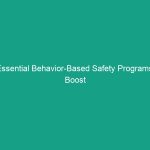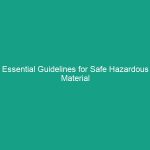Introduction
Good morning team! Today, we are going to discuss a crucial topic that affects all of us in our daily operations: Essential Unloading Trailer Guidelines: Avoid Critical Safety Risks. Understanding these guidelines is vital for ensuring our Safety and the safety of our colleagues while unloading trailers. By following these practices, we can prevent accidents, injuries, and even fatalities in our workplace. So, let’s dive into why these guidelines are important and how they impact our work every day.
Understanding Essential Unloading Trailer Guidelines
The Essential Unloading Trailer Guidelines encompass a set of safety protocols designed to mitigate risks associated with unloading trailers. These guidelines are important because unloading is often a high-risk activity that can lead to serious injuries if not performed correctly. Understanding these guidelines helps you recognize potential Hazards and equips you with the knowledge to perform your tasks safely.
A common misconception is that unloading trailers is a straightforward task that doesn’t require much thought or preparation. However, this belief can lead to oversights that create dangerous situations. Remember, safety is everyone’s responsibility, and being aware of the risks involved is the first step in preventing accidents.
Key Hazards, Risks, and Safety Considerations
When unloading a trailer, several specific hazards and risks can arise. Here are some of the most significant:
- Falling Loads: Items that are improperly secured can fall during unloading, posing a risk of injury to employees below.
- Slips, Trips, and Falls: The unloading area can be cluttered, and wet or uneven surfaces can lead to slips and falls.
- Equipment Malfunction: Forklifts and other machinery used in unloading can malfunction or be improperly operated, leading to accidents.
- Overexertion Injuries: Lifting heavy objects incorrectly can lead to musculoskeletal injuries, such as strains and sprains.
Ignoring safety protocols can lead to severe consequences, including serious injuries, loss of productivity, and increased insurance costs for the company. It’s essential to remain vigilant and proactive about safety.
Best Practices, Procedures, & Actionable Advice
To ensure safety while unloading trailers, follow these Best Practices:
Step-by-Step Safety Procedures
- Conduct a Pre-Operation Inspection: Before starting the unloading process, inspect the unloading area for hazards. Check that all equipment is functioning correctly.
- Use Proper Equipment: Ensure you are using the right equipment for the job, such as forklifts, pallet jacks, or hand trucks. Make sure they are in good working condition.
- Secure the Trailer: Ensure that the trailer is securely parked and that wheel chocks are in place to prevent movement during unloading.
- Wear Personal Protective Equipment (PPE): Always wear the required PPE, including gloves, safety shoes, and hard hats.
- Follow Safe Lifting Techniques: When lifting items manually, keep your back straight, bend at your knees, and hold the load close to your body.
- Communicate Clearly: Use hand signals or verbal commands to maintain clear communication with team members during unloading.
Practical Tips and Real-Life Examples
Let’s look at some practical tips to enhance safety during unloading:
- Always unload heavier items first to maintain balance in the trailer.
- Keep aisles clear and organized to prevent tripping hazards.
- Utilize spotters when operating machinery to help navigate tight spaces.
For example, in a recent incident, a worker suffered an injury when a load shifted while being unloaded. This could have been avoided if the load had been properly secured and if the worker had communicated effectively with their team.
Regulations, Standards, and Compliance
It’s important to be aware of the Regulations and Standards that govern unloading operations. Compliance with OSHA regulations is critical to maintaining a safe workplace. For instance:
- osha requires that all employees receive proper Training for operating forklifts and other equipment.
- Employers must ensure that loading and unloading areas are free from hazards.
Adhering to these standards not only protects employees but also helps avoid legal consequences for the company. Safety should always be a top priority, and compliance is a key aspect of that commitment.
Employee Engagement & Discussion
Now that we’ve covered the guidelines and Best Practices, let’s open the floor for discussion. Think about your experiences with unloading trailers:
- What safety challenges have you encountered related to this?
- Are there any additional tips you think could enhance our unloading safety procedures?
Your insights and experiences are invaluable as we work together to improve our Workplace Safety culture.
Conclusion & Key Takeaways
To sum up, understanding and adhering to Essential Unloading Trailer Guidelines is crucial for preventing accidents and ensuring the safety of everyone involved in the unloading process. Remember to conduct pre-operation inspections, use proper equipment, communicate effectively, and follow safe lifting techniques.
Let’s make a commitment to prioritize safety in our daily operations. Thank you for your attention and your ongoing commitment to maintaining a safe workplace. Together, we can make a difference!


